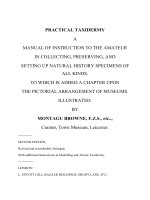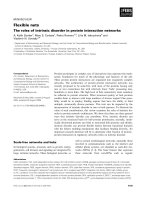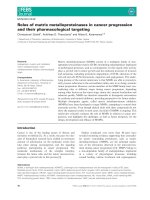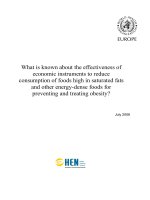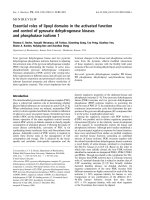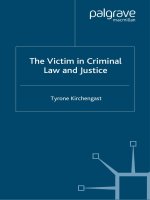The roles of the internet in reconfigering maggies in australia, USA and UK
Bạn đang xem bản rút gọn của tài liệu. Xem và tải ngay bản đầy đủ của tài liệu tại đây (233.63 KB, 25 trang )
Mate Selection in the Network Society:
The Role of the Internet in Reconfiguring Marriages in Australia, the United
Kingdom and United StatesA
William H. Dutton, Ellen J. Helsper and Monica T. Whitty
Oxford Internet Institute, University of Oxford
and
J. Galen Buckwalter and Erina Lee
eHarmony LabsTM
The Internet has the potential to change our lives for better or worse by
reconfiguring social networks, ranging from creating an expanded set of weak
ties to introducing people to their next best friend or spouse. Cyberspace is not
the utopian playfield some portrayed it to be (Rheingold 1994). While many
increasingly look to the Internet as a place to meet people, others fear
undesirable or unwanted approaches in chat rooms or over social networks.
Nonetheless, there is evidence that a considerable number of people are
meeting new people online and that they sometimes move on to meet up face-toface. This is evident in the degree that online dating sites have spawned a
burgeoning new industry.
A
This working paper was prepared for discussion at a forum, entitled ‘Meeting, Dating, Marriage and the
Internet’, held at the Oxford Internet Institute, University of Oxford, 3 October 2008. The research was
supported by a grant from eHarmony, a US based online match-making company supporting research on
the science of relationships.
1
Electronic
Electroniccopy
copyavailable
availableat:
at: /> />
What will be the societal implications of an increasing number of people making
friends and possibly establishing intimate relationships online? This paper seeks
to address this question through an analysis of survey research data gathered as
part of the ‘Me, My Spouse and the Internet’ project at the Oxford Internet
Institute, supported by eHarmony. This study collected in Britain and Australia
enables us to address key questions related to the prevalence and patterns of
Internet-enabled meeting and marriage. When possible, we draw comparisons
with other survey data on online relationships, such as from a survey on recently
married individuals in the United States. It draws also from general population
data collected by the Oxford Internet Surveys (OxIS), as discussed below.
Reconfiguring Relationships
Theoretical assumptions underpinning many discussions of online relationships
have tended to be technologically deterministic, and focused on the role of the
Internet in reducing or enhancing social networks (Rice et al 2007). The question
most often posed is whether or not the Internet will tend to isolate people or
extend their social networks. Generally, survey research has failed to find a
consistent relationship between Internet use and social relationships. If anything,
those online have tended to be somewhat more sociable, despite early
stereotypes of the isolated computer nerd (Rice et al 2007). Our research has
moved away from this focus on more or less connectivity to explore the degree to
2
Electronic
Electroniccopy
copyavailable
availableat:
at: /> />
which people use the Internet to make new friends and, thereby, reconfigure their
social networks.1
For example, bi-annual surveys of use and non-use of the Internet in Britain have
examined those who create new ties through the Internet and under what
conditions these online ties migrate to face to face settings (Dutton and Helsper
2007). These analyses are based on data from the 2005 and 2007 Oxford
Internet Surveys (OxIS), each of which is based on a national probability sample
survey of individuals aged 14 and over in Britain.
Figure 1 Meeting People Online
Source: OxIS (Dutton & Helsper, 2007)
The Oxford Internet Surveys (OxIS) showed, for example, that in 2007, almost a
quarter of Internet users (23%) had met someone online who they did not know
before. This is up from 20 percent in 2005 (Figure 1). Not only did Internet users
3
Electronic copy available at: />
meet new friends online, about half of these individuals have gone on to meet
one or more of these virtual friends in person (di Gennaro and Dutton 2007;
Dutton and Helsper 2007). These findings suggest that the Internet plays an
important role in reconfiguring the social networks of many users.
Socio-demographic characteristics, such as being single, shape patterns of
Internet use, and are related to the greater propensity of some individuals to
make online social relationships (di Gennaro and Dutton 2007). However,
experience with the Internet and the ways in which people choose to use the
Internet, such as for chatting or communicating more generally, are most directly
associated with who makes new connections over the Internet and who does not.
Also, multivariate analysis indicates that the dynamics of online friendships are
driven more by the idiosyncratic digital choices made by users of the Internet,
such as to participate in a social networking site, than by any mechanistic social
or technological determinism (di Gennaro and Dutton 2007). Individuals choose
to use the Internet in ways that enable them to meet others. Meeting new friends
is not strongly associated with any particular social group, or with the use of the
Internet per se.
We have sought to extend this research beyond ‘friendship’ to a more concrete
and intimate relationship by asking whether the same dynamics apply to
marriage. Will individuals meet people online who they would not otherwise meet,
and not only meet in person, but also develop a relationship that leads to
4
Electronic copy available at: />
marriage? These questions include the following: What role has the Internet
played in introducing married couples? For example, what proportion of married
couples met online?
If some couples have met online, what difference has it made? Are couples that
met online more diverse or more homogeneous in their geographic and
socioeconomic backgrounds compared with people who meet offline? It may be
that the Internet is enabling people to meet types of individuals that they do not
have access to offline. Do partners who meet online meet others who are more
or less similar to them (e.g., similar interests, age)?
Alternatively, will couples who meet online and offline be significantly different
from one another? Will men and women be attracted to similar characteristics to
the ones they are traditionally attracted to offline? For example, will online
couples place more emphasis in emotional characteristics than physical ones?
Ever since the early days of the Internet, researchers have questioned its utility in
developing and maintaining psychological healthy friendships, romantic
relationships and sexual relations. Early researchers were fairly skeptical about
the benefits of online relationships arguing that there were not enough indicators
in interactions through computers that could convey the complex emotions
needed to maintain intimate relationships.2 However, this thesis has been
challenged by research on computer-mediated communication, which tends to
5
Electronic copy available at: />
demonstrate that, in some circumstances, intense personal relationships can be
fostered online – what Walter (1996) has called ‘hyper-personal relationships’.
Meeting a Future Spouse
Despite the growth of online dating services, and much anecdotal evidence of
couples meeting online, there is much doubt over the frequency and vitality of
online match making. However, despite all the early negativity, researchers
across the globe have found ample evidence that people do make friends and
initiate romantic relationships in cyberspace and often these relationships
progress offline (McKenna, Green, and Gleason 2002; Whitty 2008). While we
are left in little doubt that people can and do form relationships online, we know
little about which role the Internet plays in intimate offline relationships.
Obviously, this is important given that the Internet has become another mode of
communication in many people’s everyday lives.
Approach and Methods
The ‘Me, My Spouse and the Internet’ study focused on collecting basic
information about how many married people have met their partners and
identifying those who met online. We explored a number of other issues, such as
how married couples use the Internet within their relationships3, but this paper
focuses on who meets online and how might this be reconfiguring marriages in
6
Electronic copy available at: />
the network society. We draw comparisons using a separate survey of recently
married individuals in the United States, which collected the same information on
who meets online and how they met. Both surveys were conducted online.
Online Survey Samples
We obtained samples of married couples through online panels in the UK and
Australia and a sample of married individuals through an online panel in the US.
For the UK and Australia, survey organizations with online panels sampled
married individuals who were in their panels, offering a fee if they and their
spouse completed separate online questionnaires. Through this process we were
able to obtain probability samples of online marrieds in each country, 920
married couples in the UK, 748 couples in Australia, and 10,675 recently married
individuals in the US, who used the Internet (Table 1). The UK sample was
weighted to better reflect our estimates of online married couples in the UK,
based on OxIS data on age and education. We did not have comparable data to
weight the Australian sample. The US sample was weighted to represent
recently married US residents between 20-54 years of age only. We will draw
attention to the differences across these samples, but it should be kept in mind
that the US sample is focused on recently married couples, and is therefore likely
to capture a larger percentage of couples with the opportunity to have met online.
7
Electronic copy available at: />
Table 1. Samples of Online Married Couples in the UK and Australia.
Fieldwork
Sample
Respondents
Weighting
UK
Australia
US
October 2007
November 2007
November 2007
Married couples
Married couples
who used the
who used the
internet
internet
2,401 Individuals
1,496 Individuals
929 Couples
748 Couples
Weighted to
Unweighted
Recently married
individuals who
used the internet
10,675 Individuals
Weighted to
Represent Married
represent recently
Internet Users
married US
residents between
20-54
The characteristics of individuals in each sample are compared in Table 2. On
average, the survey sample in the UK was somewhat older (49 years v 42 years
of age), and married longer (19 v 13 years), but with fewer children (1.6 v 1.9) on
average, largely due to a larger proportion of married couples in the UK not
having children (24% v. 18%). Given our sampling frames, it is not surprising that
compared to either the UK or Australian sample, the survey sample of recently
8
Electronic copy available at: />
married individuals in the US was younger (32 years), married for a much shorter
period of time (10 months), and had a larger proportion of married couples
without children (52%).
Table 2. Composition of the Sample, UK, Australia, and US
Characteristic
UK
Australia
US
Mean Age
49 years
42 years
32 years
Mean Length Married
19 years
13 years
10 months
Number of Children
1.6
1.9
1.0
% Without Children
24
18
52
The Role of the Internet in Meeting Partners
Our surveys indicate that the Internet is indeed playing a significant role in
introducing couples. In the UK, about 6 percent of married couples who use the
Internet have met their partners online. In Australia, the percentage was higher, 9
percent saying they met their partner online. For the younger, more recently
married sample in the US, the percentage was even higher, with 19% of
individuals meeting their partners online (Figure 2).
9
Electronic copy available at: />
Figure 2 Did you first meet your current partner online or offline?
Meeting Partner Online
Australia
Meeting Partner Online
UK
Online
6%
Online
9%
Offline
91%
Offline
94%
Meeting Partner Online
US
Online
19.2%
Offline
80.8%
Source: Me, My Spouse and the Internet Study
The largest proportion of married couples that met online is middle aged, 26 to
55 years of age (Figure 3). In Australia, the largest proportion of married couples
who met online are from 26 to 35 years of age. In Britain, the largest proportion is
from 36 to 45 years of age, and in the US, the largest proportion is from 46 to 55
years of age. This middle age group tends to reflect the larger proportion of
10
Electronic copy available at: />
married couples in these age brackets. In contrast, analyses which examine the
percentage of couples within each age group that met online, show that younger
people were more likely to have met their partner online (see Figure 4). In the
UK, a fifth (21%) of married individuals between 19 and 25 years of age met their
spouse online, while in Australia, this figure was even higher, one-third (34%). In
the US, the largest percentage of individuals meeting online (42%) came from
the age group between 26 to 35 years of age.
Figure 3. Percentage of Individuals who Met Online by Age.
People who met online by age
UK, Australia, and US
% of couples who met online
UK
100
90
80
70
60
50
40
30
20
10
0
Australia
US
48
40
29
24
26
12
6 9
19-25
18
26-35
36-45
31
20
12
46-55
7
2
56-65
11
Electronic copy available at: />
Figure 4. Percentage of Each Age Group Who Met Online, UK, Australia.
Meeting the partner online by age (* * )
UK, Australia & US
% of couples who met online
UK
100
90
80
70
60
50
40
30
20
10
0
34
21
Australia
US
42
25
16
15
9
87
17
53
2
8
00
19-25 26-35 36-45 46-55 56-65 66-75
00
76+
Where People Meet in Cyberspace
We asked those respondents who met their spouse online whether they met their
future spouse through an online dating site, in a chat room, a social networking
site, on e-mail or in a variety of other online spaces. In the UK, an online dating
site was the most frequently mentioned, by 34 percent (Figure 5). This was
followed by online chat rooms (19%) and instant messaging (18%). In Australia,
12
Electronic copy available at: />
the chat room was the most frequently mentioned, by 26 percent (Figure 5),
followed by either an online dating site (for 23%) or instant messaging (18%),
which was similar to the UK. All other locations were far less frequently cited,
including social networking sites, mentioned by less than 5%. The pattern in the
US was similar to that of the UK, with most people meeting through an online
dating site (49%), followed by chat rooms (13%), and instant messaging (12%).
There was also a large portion of people in the US sample meeting through
social networking sites (12%).
Figure 5. Where People Met Their Spouse Online.
Where did online couples meet?
UK, Australia & US
UK
Australia
US
100
90
% who met online
80
70
60
49
50
40
30
34
26
19
13
23
20
1818
12
10
6
32
654
12
5
12
4
422
43
332
1
5
1
0
Online dating
site
Chat room
Instant
messaging
(e.g., Yahoo!,
Messenger,
Skype, AIM)
Online
community
Other
Discussion Message or
Social
Multi-Player
group or comment on a
Online game networking
(e.g., World of site (e.g., bulletin board personal
website
MySpace,
Warcraft,
Facebook,
Halo)
Bebo)
13
Electronic copy available at: />
These age distributions and locations of meeting, suggest that the frequency of
couples meeting online is likely to increase in the coming years. Younger couples
are more likely to meet online, and OxIS suggests that those growing up with the
Internet are likely to take this medium as a more natural place to meet people,
generally (Dutton & Helsper 2007). Also, social networking sites are becoming
more prominent in linking people through common friends and social networks.4
So what difference will this make?
The Differences Across Those Introduced Online, or Offline: The UK Case
Given a sizeable, and possibly growing, proportion of couples that meet online, it
is critical to ask whether individuals are likely to meet people online, whom they
might not meet through more traditional paths. Our general hypothesis was that
online media would diminish more traditional cues, such as age, and therefore
enable people to initiate a relationship with someone whom they might not
otherwise even strike a conversation. If this is the case, we should see significant
differences between the characteristics of couples that met online, compared to
those who met offline.
To explore this potential, we compared UK couples on two basis attributes, age
and educational background. We hypothesized that couples that met online are
less likely to be deterred by a person’s age difference, since this will not be as
14
Electronic copy available at: />
apparent in the online setting, and not as driven by one’s existing social
networks. Likewise, we expected couples that met in more traditional ways to
marry individuals with similar educational backgrounds, since they would be
more likely to be in similar social networks. In both areas, we found online
couples to have a great likelihood of having a spouse with a greater gap in their
ages or educational background.
Figure 6. Age Differences Between Couples Whom Met On- and Off-Line.
Couples who met online by Age Difference (*)
UK
Online
Offline
100
76
% of Married Couples
80
61
60
39
40
24
20
0
Age Difference < 6 years
Age Difference > 6 years
Figure 6 shows that in the UK, couples that met online are more likely to have a
difference in their age of greater than 6 years. 39 percent of online couples have
an age difference greater than 6 years, compared with 24 percent of couples that
met in more traditional ways.
15
Electronic copy available at: />
Figure 7 illustrates our findings for educational backgrounds. Couples who met
online are more likely to have a difference in their educational backgrounds. In
the UK, we compared couples who both had a university degree, or who both did
not have a university degree, and those in which one partner had a university
degree and one partner did not. 36 percent of online couples had a difference in
their educational backgrounds, compared to 21 percent who met in other, more
traditional ways.
Figure 7. Educational Differences Between On- and Off-Line Couples.
Couples who met online by Education Difference (with and
without university degree) (*)
UK
Online
Offline
100
79
% of Married Couples
80
64
60
36
40
21
20
0
No difference in Education
Difference in Education
16
Electronic copy available at: />
Different Motivations or Priorities
It could be that people who meet online are simply less interested in some
attributes, such as age and education, than are people who prefer and tend to
meet people in more traditional ways and that this lessened interest may apply to
additional partner qualities, such as physical attraction. Since online couples
spend time chatting and getting to know one another online, it could be that they
place greater importance in qualities like personality and emotional attraction
instead. We therefore asked individuals how important they rated a variety of
attributes of their partner. These were grouped into three scales: the partner’s
personality, emotional attraction, and physical attraction.
As Figure 8 shows, those who met their partner online do not place less
importance on physical attraction than do those who met each other in other
ways. In fact, people who met their spouse online are likely to place more
importance on all of these attributes – personality, emotional characteristics, and
physical attraction – than are those who met their partner offline (Figure 8). This
is a statistically and substantively meaningful and consistent difference in ratings.
An alternative interpretation is that those who go online to meet their partner
might be less selective about certain partner qualities, like similarity in age and
17
Electronic copy available at: />
education, and well be more selective, devoting more time to search for other
attributes such as personality, emotional characteristics, and physical attraction.
Figure 8. Ratings of Attributes by Online and Offline Couples.
Importance of Partner's Attributes by how People met
UK
Online
Offline
7
6.2
6
5.9
5.8
5.6
5.4
5.0
Importance (1-7)
5
4
3
2
1
0
Partner's Personality (**)
Emotional Attraction (**)
Physical Attraction (**)
Similarities and Differences in Interests
It could also be that online couples place more importance in finding people with
similar interests, since many online meetings occur in chat rooms, sometimes
gaming sites, and other areas where like-minded individuals might go. Figure 9
18
Electronic copy available at: />
shows that people who met their partner online or offline are not dramatically
different in their interests. Both categories of partners value friendship, and going
out. However, couples who met offline are significantly more likely to value a
number of other activities, including ‘music and entertainment’, ‘socializing’,
‘community involvement’, ‘entertaining’, and ‘religion’ (Figure 9). Those who met
online are more interested in more things.
Figure 9. Interests and Activities of Online and Offline Couples.
Interests and Activities by how People met
UK
Online
Offline
7
How interesting (1-7)
6
5.6 5.6
5.3 5.1
5
4.9
4.5
4.7
4.4
4.6
4.5
4.1
4.0
4
3.1
3
2.4
2
1
0
Friendship ( )
Going Out ( )
Music and
Socializing (*)
Entertainment
(**)
Community
Involvement
(**)
Entertaining
(**)
Religion (**)
However, it may be that those who met online have more similar interests, which
could be one reason why age and educational backgrounds appear less
determinative of relationships. Figure 10 shows that couples who met online are
less likely to have different interests from their partner. While statistically weak,
19
Electronic copy available at: />
these differences between partners’ interests, such as in ‘socializing’, might be
larger for couples that met offline (Figure 10).
Figure 10. Differences in Interests Between Online and Offline Couples.
Couple Differences in Interests by how they met
UK
Online
Offline
Differences between Partner's Interests
1.2
1.0
1.0 1.0
1.0
1.1
1.0
1.0
1.0
0.9
0.8
0.8
0.8
0.9
0.8
0.8
0.6
0.6
0.4
0.2
0.0
Entertaining
Community
Involvement
Religion
Socializing
Music and
Entertainment
Friendship
Going Out
Summary and Discussion
This exploratory study of the role of the Internet in reconfiguring marriages,
introducing couples that meet in person and later marry, was anchored in online
surveys of married couples in Britain, Australia, and the US. We found that a
sizeable proportion of online married couples in each country first met their
spouse online, usually through an online dating service, chat room or on instant
20
Electronic copy available at: />
messaging (IM). This is more prominent for younger couples, but many couples
at all ages can be found who met online. Given the recent and growing
prominence of social networking, and online dating services, this proportion is
likely to grow in the future.
Will this make a difference in that people meet, and therefore have major
implications for the evolution of society – literally? Our initial findings based on
UK couples indicate that meeting online is likely to introduce people to others
whom they would not be as likely to meet through other means. It opens people
to more diversity in their choice of a partner, such as by introducing individuals
with greater differences in age or education, but with more similar interests and
values. The findings also suggest that couples who meet online place great
emphasis in a variety of partner characteristics, suggesting that meeting
someone online may be a more measured approach for people interested in
finding a partner. Alternatively, it could be that interactions online are driven more
by cognitions, rather than emotions, leading people to be more attentive to
characteristics important to them, and less influenced by emotional responses.
These findings are preliminary, but suggestive of significant social trends and
indirect implications of social networking in the digital age. Based on these
observations, we are planning to extend our analyses of the differences across
couples introduced online and offline to our Australian and US samples. Also, we
are planning additional surveys in more countries that can examine the degree
21
Electronic copy available at: />
that these findings can be supported in other contexts overtime. It will also be
important to develop more qualitative studies that help develop and validate
alternative explanations for the findings that have been discovered by this study.
References
Di Gennaro, C., and Dutton, W. H. (2007), ‘Reconfiguring Friendships: Social
Relationships and the Internet’, Information, Communication and Society, 10(5):
591-618.
Dutton, W. H. (1999), Society on the Line: Information Politics in the Digital Age,
Oxford and New York: Oxford University Press.
Dutton, W. H. (2005), ‘The Internet and Social Transformation: Reconfiguring
Access,’ pp. 375-97 in Dutton, W. H., Kahin, B., O’Callaghan R., and Wyckoff, A.
W. (eds.), Transforming Enterprise, Cambridge, MA: MIT Press.
Dutton, W. H. and Helsper, E. (2007), The Internet in Britain. Oxford: Oxford
Internet Institute, University of Oxford.
McKenna, K. Y. A., Green, A. S., and Gleason, M. E. J. (2002), ‘Relationship
Formation on the Internet: What’s the Big Attraction? Journal of Social Issues,
58(1): 9-31.
22
Electronic copy available at: />
Rheingold, H. (1994), The Virtual Community: Finding Connection in a
Computerized World. London: Secker & Warburg.
Rice, R. e., Shepherd, A., Dutton, W. H., and Katz, J. E. (2007), ‘Social
Interaction and the Internet: Ca Comparative Analysis of Surveys in the US and
Britain’, in Oxford Handbook of Internet Psychology, eds A. N. Joinson, K. Y. A.,
McKenna, T. Postmes, and U. R. Reips, Oxford University Press, Oxford, pp. 730.
Short, J., Williams, E., & Christie, B. (1976), The Social Psychology of
Telecommunications. London: John Wiley & Sons.
Sproull, L. & Kiesler, S. (1986) Reducing Social Context Cues: Electronic Mail in
Organizational Communication. Management Science, 32 (11): 1492-1512.
Walther, J. B. (1996), ‘Computer-Mediated Communication: Impersonal,
Interpersonal and Hyperpersonal Interaction’. Communication Research, 23(1):
3-43.
Whitty, M. T., and Carr, A. (2006), Cyberspace Romance: The Psychology of
Online Relationships. London: Palgrave.
23
Electronic copy available at: />
Whitty, M. T., Baker, A. J., and Inman, J. A. (2007) (eds), Online Matchmaking.
London: Palgrave.
Whitty, M.,T., Helsper, E. J., and Dutton, W. H. (2008), ‘Netiquette and
Surveillance Among Married Couples’, paper submitted for presentation at
OZCHI 2008, December 8-12, 2008, Cairns, QLD, Australia.
Authors
Galen Buckwalter is Chief Scientist, Research and Development at eHarmony
Labs™
William Dutton is Professor of Internet Studies at the OII, University of Oxford.
Ellen Helsper is Survey Research Fellow at the OII, University of Oxford.
Erina Lee is a Research Scientist, Research and Development and eHarmony
Labs™
Monica Whitty is Senior Lecturer at the School of Social Sciences, Nottingham
Trent University, UK and a Research Associate of the OII, University of Oxford
24
Electronic copy available at: />
Notes
1
For a development of this thesis, see di Gennaro and Dutton (2007).
2
Some of the earliest research in this vain was based on studies of audio and
video teleconferencing, which argued that mediated telecommunications lacked
the same level of ‘social presence’ provided by face to face communication
(Short, Williams and Christie 1976). This same model has been prominent since
then, extending to studies of the Internet (Sproull and Kiesler 1986).
3
We wanted to learn more about couples’ netiquette; that is their expectations
about each other’s online activities and if some online activities were seen as
taboo. Furthermore, we were interested in how couples use the Internet to
monitor each other’s online activities. Early findings on these issues are
discussed by Whitty et al (2008).
4
See for example, PEW Internet Project data on social networking trends in the
US at: />
25
Electronic copy available at: />

